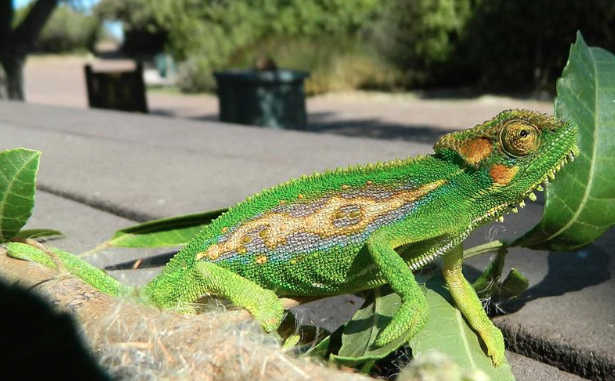With the onset of autumn, the Cape dwarf chameleon, also known as trapsuutjies in Afrikaans, should be delivering offspring ahead of the rains that usually occur around this time. Residents of Cape Town are therefore urged to look out for baby chameleons. These young reptiles tend to be brown in colour. At birth a baby chameleon can fit on the tip of one’s forefinger but soon grow much bigger.
“Cape dwarf chameleons give live birth to between 5 to 15 babies at a time. Newborns then drop and stick to vegetation, after which they are immediately self-sufficient,” said City Mayco Member for Spatial Planning and Environment, Marian Nieuwoudt.
The grown Cape dwarf chameleons vary in shades of green and grey with their average maximum length around 14 cm. Those in denser, closed vegetation areas tend to be larger and brightly coloured.
The Cape dwarf chameleon’s tongue can be as long or even longer than its body. It has been recorded to shoot out at a speed of 20km/h to catch prey. They feed primarily on small insects and drink by licking dew or rain drops from leaves or other surfaces.
“Residents will have better luck in finding these creatures on warmer days. Being cold-blooded, they are more active when the sun is out and are likely to be found taking shelter deeper in vegetation on cold and windy days,” she added. “Anyone interested to assist the City in tracing where these chameleons reside in Cape Town, can join the survey by uploading a photo of the chameleon found on the iNaturalist app or website. Residents are reminded to please respect the lockdown rules, and to remain on their properties while on the lookout for the Cape dwarf chameleons.”
A common misconception is that chameleons change their colour for camouflage to blend into the environment. Chameleons actually change colour as a way of expressing mood and communicating. They also turn a darker colour to absorb more heat or a very pale pastel colour to reflect light and absorb less heat.
“If residents have difficulty finding them during the day, doing the survey at night with a bright torch could be a better option and a more adventurous activity for the kids. The Cape dwarf chameleon tends to be near the tips of branches at night and appears as a pale milky colour in the torch light,” said Nieuwoudt.
The Cape dwarf chameleon’s historical habitat has become severely fragmented due to urbanisation and agricultural transformation. Additional losses are expected to occur because of rapid climatic change.
Once again, we are reminded of how incredibly diverse and special the biodiversity is in Cape Town.
The City asks that residents record their findings but refrain from moving chameleons from their suitable habitats; they are also never to be kept in captivity. By simply checking the garden refuse and vegetation while pruning, one can prevent these chameleons from accidentally being transported to a landfill site.
The following link can be used when uploading findings: https://www.inaturalist.org/projects/chameleons-of-cape-town-atlas
Picture: Supplied






